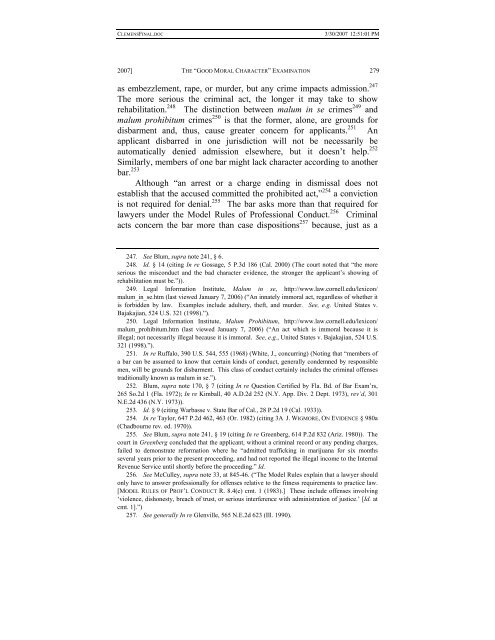Facing the Klieg Lights: Understanding the "Good Moral Character"
Facing the Klieg Lights: Understanding the "Good Moral Character"
Facing the Klieg Lights: Understanding the "Good Moral Character"
Create successful ePaper yourself
Turn your PDF publications into a flip-book with our unique Google optimized e-Paper software.
CLEMENSFINAL.DOC<br />
3/30/2007 12:51:01 PM<br />
2007] THE “GOOD MORAL CHARACTER” EXAMINATION 279<br />
as embezzlement, rape, or murder, but any crime impacts admission. 247<br />
The more serious <strong>the</strong> criminal act, <strong>the</strong> longer it may take to show<br />
rehabilitation. 248 The distinction between malum in se crimes 249 and<br />
malum prohibitum crimes 250 is that <strong>the</strong> former, alone, are grounds for<br />
disbarment and, thus, cause greater concern for applicants. 251 An<br />
applicant disbarred in one jurisdiction will not be necessarily be<br />
automatically denied admission elsewhere, but it doesn’t help. 252<br />
Similarly, members of one bar might lack character according to ano<strong>the</strong>r<br />
bar. 253 Although “an arrest or a charge ending in dismissal does not<br />
establish that <strong>the</strong> accused committed <strong>the</strong> prohibited act,” 254 a conviction<br />
is not required for denial. 255 The bar asks more than that required for<br />
lawyers under <strong>the</strong> Model Rules of Professional Conduct. 256 Criminal<br />
acts concern <strong>the</strong> bar more than case dispositions 257 because, just as a<br />
247. See Blum, supra note 241, § 6.<br />
248. Id. § 14 (citing In re Gossage, 5 P.3d 186 (Cal. 2000) (The court noted that “<strong>the</strong> more<br />
serious <strong>the</strong> misconduct and <strong>the</strong> bad character evidence, <strong>the</strong> stronger <strong>the</strong> applicant’s showing of<br />
rehabilitation must be.”)).<br />
249. Legal Information Institute, Malum in se, http://www.law.cornell.edu/lexicon/<br />
malum_in_se.htm (last viewed January 7, 2006) (“An innately immoral act, regardless of whe<strong>the</strong>r it<br />
is forbidden by law. Examples include adultery, <strong>the</strong>ft, and murder. See, e.g. United States v.<br />
Bajakajian, 524 U.S. 321 (1998).”).<br />
250. Legal Information Institute, Malum Prohibitum, http://www.law.cornell.edu/lexicon/<br />
malum_prohibitum.htm (last viewed January 7, 2006) (“An act which is immoral because it is<br />
illegal; not necessarily illegal because it is immoral. See, e.g., United States v. Bajakajian, 524 U.S.<br />
321 (1998).”).<br />
251. In re Ruffalo, 390 U.S. 544, 555 (1968) (White, J., concurring) (Noting that “members of<br />
a bar can be assumed to know that certain kinds of conduct, generally condemned by responsible<br />
men, will be grounds for disbarment. This class of conduct certainly includes <strong>the</strong> criminal offenses<br />
traditionally known as malum in se.”).<br />
252. Blum, supra note 170, § 7 (citing In re Question Certified by Fla. Bd. of Bar Exam’rs,<br />
265 So.2d 1 (Fla. 1972); In re Kimball, 40 A.D.2d 252 (N.Y. App. Div. 2 Dept. 1973), rev’d, 301<br />
N.E.2d 436 (N.Y. 1973)).<br />
253. Id. § 9 (citing Warbasse v. State Bar of Cal., 28 P.2d 19 (Cal. 1933)).<br />
254. In re Taylor, 647 P.2d 462, 463 (Or. 1982) (citing 3A J. WIGMORE, ON EVIDENCE § 980a<br />
(Chadbourne rev. ed. 1970)).<br />
255. See Blum, supra note 241, § 19 (citing In re Greenberg, 614 P.2d 832 (Ariz. 1980)). The<br />
court in Greenberg concluded that <strong>the</strong> applicant, without a criminal record or any pending charges,<br />
failed to demonstrate reformation where he “admitted trafficking in marijuana for six months<br />
several years prior to <strong>the</strong> present proceeding, and had not reported <strong>the</strong> illegal income to <strong>the</strong> Internal<br />
Revenue Service until shortly before <strong>the</strong> proceeding.” Id.<br />
256. See McCulley, supra note 33, at 845-46. (“The Model Rules explain that a lawyer should<br />
only have to answer professionally for offenses relative to <strong>the</strong> fitness requirements to practice law.<br />
[MODEL RULES OF PROF’L CONDUCT R. 8.4(c) cmt. 1 (1983).] These include offenses involving<br />
‘violence, dishonesty, breach of trust, or serious interference with administration of justice.’ [Id. at<br />
cmt. 1].”)<br />
257. See generally In re Glenville, 565 N.E.2d 623 (Ill. 1990).
















